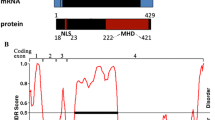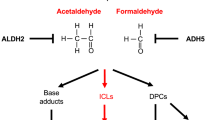Abstract
Erythropoietin-producing hepatocellular receptor-2 (EphA2) overexpression is prevalent in many types of human cancers, and it has been reported that high EphA2 expression is correlated with malignancy. Recent studies revealed that processing of EphA2 by cleaving off the N-terminal portion by membrane-type 1 matrix metalloproteinase (MT1-MMP) promotes invasion via stimulation of Ras in cancer cells in vitro. The objectives of this study were to investigate the presence and role of EphA2 processing in cutaneous squamous cell carcinoma (SCC) tissues. EphA2 (C-terminal and N-terminal) and MT1-MMP expression patterns and levels were analyzed immunohistochemically in SCC (n = 70) and Bowen disease (BD; n = 20). Levels of MT1-MMP and EphA2 expression were evaluated using digital image analysis. Proximity between MT1-MMP and EphA2 in cancer cells and its effect on EphA2 processing were investigated using a combination of in situ proximity ligation assay (PLA) and Western blotting. Immunohistochemical analyses showed that levels of EphA2 N-terminal expression were significantly lower than those of EphA2 C-terminal expression in SCC, whereas levels of EphA2 C- and N-terminal expression were similar in BD. Western blotting showed processed EphA2 fragments in human SCC tissues. Expression levels of MT1-MMP, EphA2, and processed EphA2 fragments were higher in SCC than BD. Proximity between MT1-MMP and EphA2 in SCC was demonstrated by in situ PLA. Our results suggest possible involvement of MT1-MMP processing of EphA2 in invasiveness of cutaneous SCC.





Similar content being viewed by others
References
Teramoto Y, Nakamura Y, Yamada K, Yamamoto A (2014) Oral S-1 in advanced cutaneous squamous cell carcinoma. J Dermatol 41(6):494–497. doi:10.1111/1346-8138.12498
Kerkela E, Saarialho-Kere U (2003) Matrix metalloproteinases in tumor progression: focus on basal and squamous cell skin cancer. Exp Dermatol 12(2):109–125
Roh MR, Zheng Z, Kim HS, Kwon JE, Jeung HC, Rha SY, Chung KY (2012) Differential expression patterns of MMPs and their role in the invasion of epithelial premalignant tumors and invasive cutaneous squamous cell carcinoma. Exp Mol Pathol 92(2):236–242. doi:10.1016/j.yexmp.2012.01.003
Hernandez-Perez M, El-hajahmad M, Massaro J, Mahalingam M (2012) Expression of gelatinases (MMP-2, MMP-9) and gelatinase activator (MMP-14) in actinic keratosis and in in situ and invasive squamous cell carcinoma. Am J Dermatopathol 34(7):723–728. doi:10.1097/DAD.0b013e31824b1ddf
Zelinski DP, Zantek ND, Stewart JC, Irizarry AR, Kinch MS (2001) EphA2 overexpression causes tumorigenesis of mammary epithelial cells. Cancer Res 61(5):2301–2306
Thaker PH, Deavers M, Celestino J, Thornton A, Fletcher MS, Landen CN, Kinch MS, Kiener PA, Sood AK (2004) EphA2 expression is associated with aggressive features in ovarian carcinoma. Clin Cancer Res 10(15):5145–5150. doi:10.1158/1078-0432.ccr-03-0589
Brannan JM, Dong W, Prudkin L, Behrens C, Lotan R, Bekele BN, Wistuba I, Johnson FM (2009) Expression of the receptor tyrosine kinase EphA2 is increased in smokers and predicts poor survival in non-small cell lung cancer. Clin Cancer Res 15(13):4423–4430. doi:10.1158/1078-0432.ccr-09-0473
Liu F, Park PJ, Lai W, Maher E, Chakravarti A, Durso L, Jiang X, Yu Y, Brosius A, Thomas M, Chin L, Brennan C, DePinho RA, Kohane I, Carroll RS, Black PM, Johnson MD (2006) A genome-wide screen reveals functional gene clusters in the cancer genome and identifies EphA2 as a mitogen in glioblastoma. Cancer Res 66(22):10815–10823. doi:10.1158/0008-5472.can-06-1408
Taddei ML, Parri M, Angelucci A, Onnis B, Bianchini F, Giannoni E, Raugei G, Calorini L, Rucci N, Teti A, Bologna M, Chiarugi P (2009) Kinase-dependent and -independent roles of EphA2 in the regulation of prostate cancer invasion and metastasis. Am J Pathol 174(4):1492–1503. doi:10.2353/ajpath.2009.080473
Herrem CJ, Tatsumi T, Olson KS, Shirai K, Finke JH, Bukowski RM, Zhou M, Richmond AL, Derweesh I, Kinch MS, Storkus WJ (2005) Expression of EphA2 is prognostic of disease-free interval and overall survival in surgically treated patients with renal cell carcinoma. Clin Cancer Res 11(1):226–231
Margaryan NV, Strizzi L, Abbott DE, Seftor EA, Rao MS, Hendrix MJ, Hess AR (2009) EphA2 as a promoter of melanoma tumorigenicity. Cancer Biol Ther 8(3):279–288
Miyazaki T, Kato H, Fukuchi M, Nakajima M, Kuwano H (2003) EphA2 overexpression correlates with poor prognosis in esophageal squamous cell carcinoma. Int J Cancer 103(5):657–663. doi:10.1002/ijc.10860
Shao Z, Zhang WF, Chen XM, Shang ZJ (2008) Expression of EphA2 and VEGF in squamous cell carcinoma of the tongue: correlation with the angiogenesis and clinical outcome. Oral Oncol 44(12):1110–1117. doi:10.1016/j.oraloncology.2008.01.018
Liu Y, Zhang X, Qiu Y, Huang D, Zhang S, Xie L, Qi L, Yu C, Zhou X, Hu G, Tian Y (2011) Clinical significance of EphA2 expression in squamous-cell carcinoma of the head and neck. J Cancer Res Clin Oncol 137(5):761–769. doi:10.1007/s00432-010-0936-2
Holm R, de Putte GV, Suo Z, Lie AK, Kristensen GB (2008) Expressions of EphA2 and EphrinA-1 in early squamous cell cervical carcinomas and their relation to prognosis. Int J Med Sci 5(3):121–126
Wykosky J, Debinski W (2008) The EphA2 receptor and ephrinA1 ligand in solid tumors: function and therapeutic targeting. Mol Cancer Res 6(12):1795–1806. doi:10.1158/1541-7786.mcr-08-0244
Zhang J, Hughes S (2006) Role of the ephrin and Eph receptor tyrosine kinase families in angiogenesis and development of the cardiovascular system. J Pathol 208(4):453–461. doi:10.1002/path.1937
Beauchamp A, Debinski W (2012) Ephs and ephrins in cancer: ephrin-A1 signalling. Semin Cell Dev Biol 23(1):109–115. doi:10.1016/j.semcdb.2011.10.019
Wykosky J, Palma E, Gibo DM, Ringler S, Turner CP, Debinski W (2008) Soluble monomeric EphrinA1 is released from tumor cells and is a functional ligand for the EphA2 receptor. Oncogene 27(58):7260–7273. doi:10.1038/onc.2008.328
Alford S, Watson-Hurthig A, Scott N, Carette A, Lorimer H, Bazowski J, Howard PL (2010) Soluble ephrin a1 is necessary for the growth of HeLa and SK-BR3 cells. Cancer Cell Int 10:41. doi:10.1186/1475-2867-10-41
Hiramoto-Yamaki N, Takeuchi S, Ueda S, Harada K, Fujimoto S, Negishi M, Katoh H (2010) Ephexin4 and EphA2 mediate cell migration through a RhoG-dependent mechanism. J Cell Biol 190(3):461–477. doi:10.1083/jcb.201005141
Pasquale EB (2010) Eph receptors and ephrins in cancer: bidirectional signalling and beyond. Nat Rev Cancer 10(3):165–180. doi:10.1038/nrc2806
Miao H, Wang B (2012) EphA receptor signaling–complexity and emerging themes. Semin Cell Dev Biol 23(1):16–25. doi:10.1016/j.semcdb.2011.10.013
Sugiyama N, Gucciardo E, Tatti O, Varjosalo M, Hyytiainen M, Gstaiger M, Lehti K (2013) EphA2 cleavage by MT1-MMP triggers single cancer cell invasion via homotypic cell repulsion. J Cell Biol 201(3):467–484. doi:10.1083/jcb.201205176
Koshikawa N, Hoshino D, Taniguchi H, Minegishi T, Tomari T, Nam SO, Aoki M, Sueta T, Nakagawa T, Miyamoto S, Nabeshima K, Weaver AM, Seiki M (2015) Proteolysis of EphA2 converts it from a tumor suppressor to an oncoprotein. Cancer Res 75(16):3327–3339. doi:10.1158/0008-5472.can-14-2798
Okada A, Bellocq JP, Rouyer N, Chenard MP, Rio MC, Chambon P, Basset P (1995) Membrane-type matrix metalloproteinase (MT-MMP) gene is expressed in stromal cells of human colon, breast, and head and neck carcinomas. Proc Natl Acad Sci U S A 92(7):2730–2734
Poincloux R, Lizarraga F, Chavrier P (2009) Matrix invasion by tumour cells: a focus on MT1-MMP trafficking to invadopodia. J Cell Sci 122(Pt 17):3015–3024. doi:10.1242/jcs.034561
Seiki M, Koshikawa N, Yana I (2003) Role of pericellular proteolysis by membrane-type 1 matrix metalloproteinase in cancer invasion and angiogenesis. Cancer Metastasis Rev 22(2–3):129–143
Seiki M (2003) Membrane-type 1 matrix metalloproteinase: a key enzyme for tumor invasion. Cancer Lett 194(1):1–11
Koshikawa N, Mizushima H, Minegishi T, Eguchi F, Yotsumoto F, Nabeshima K, Miyamoto S, Mekada E, Seiki M (2011) Proteolytic activation of heparin-binding EGF-like growth factor by membrane-type matrix metalloproteinase-1 in ovarian carcinoma cells. Cancer Sci 102(1):111–116. doi:10.1111/j.1349-7006.2010.01748.x
Xiaoyin H, Jiandon W, Qian S, Haijin F, Xiaoxiang G, Jinghua W (2013) EphA2/CD10/Bcl-6/MUM1 contributes to subclassification of diffuse large B cell lymphoma. J Transl Med 1(3):101–106
Chu MB, Slutsky JB, Dhandha MM, Beal BT, Armbrecht ES, Walker RJ, Varvares MA, Fosko SW (2014) Evaluation of the definitions of "high-risk" cutaneous squamous cell carcinoma using the American Joint Committee on Cancer staging criteria and National Comprehensive Cancer Network guidelines. J Skin Cancer 2014:154340. doi:10.1155/2014/154340
Lisabeth EM, Falivelli G, Pasquale EB (2013) Eph receptor signaling and ephrins. Cold Spring Harb Perspect Biol 5(9). doi:10.1101/cshperspect.a009159
Weedon D, Morgan M. B, Gross C, Nagore E, Yu L (2003) World Health Organization Classification of Tumours. Pathology and genetics of skin tumours. IARC Press, Lyon
Holm R, Knopp S, Suo Z, Trope C, Nesland JM (2007) Expression of EphA2 and EphrinA-1 in vulvar carcinomas and its relation to prognosis. J Clin Pathol 60(10):1086–1091. doi:10.1136/jcp.2006.041194
Ishikawa M, Miyahara R, Sonobe M, Horiuchi M, Mennju T, Nakayama E, Kobayashi M, Kikuchi R, Kitamura J, Imamura N, Huang CL, Date H (2012) Higher expression of EphA2 and ephrin-A1 is related to favorable clinicopathological features in pathological stage I non-small cell lung carcinoma. Lung Cancer 76(3):431–438. doi:10.1016/j.lungcan.2011.12.004
Trudel D, Desmeules P, Turcotte S, Plante M, Gregoire J, Renaud MC, Orain M, Bairati I, Tetu B (2014) Visual and automated assessment of matrix metalloproteinase-14 tissue expression for the evaluation of ovarian cancer prognosis. Mod Pathol 27(10):1394–1404. doi:10.1038/modpathol.2014.32
Braun M, Kirsten R, Rupp NJ, Moch H, Fend F, Wernert N, Kristiansen G, Perner S (2013) Quantification of protein expression in cells and cellular subcompartments on immunohistochemical sections using a computer supported image analysis system. Histol Histopathol 28(5):605–610
Dennis J, Parsa R, Chau D, Koduru P, Peng Y, Fang Y, Sarode VR (2015) Quantification of human epidermal growth factor receptor 2 immunohistochemistry using the Ventana Image Analysis System: correlation with gene amplification by fluorescence in situ hybridization: the importance of instrument validation for achieving high (>95 %) concordance rate. Am J Surg Pathol 39(5):624–631. doi:10.1097/pas.0000000000000375
Acknowledgments
We thank Ms. M. Onitsuka and Ms. H. Fukagawa for excellent technical assistance in immunohistochemical and in vitro studies. This work was supported in part by grants from the Research Center for Advanced Molecular Medicine, Fukuoka University and the Izumo City Supporting Cancer Research Project.
Author information
Authors and Affiliations
Corresponding author
Ethics declarations
This study was approved by the Ethics Committee of Fukuoka University School of Medicine (No 14–9-09).
Conflict of interest
The authors declare that they have no conflict of interests.
Rights and permissions
About this article
Cite this article
Tatsukawa, R., Koga, K., Aoki, M. et al. Immunohistochemical demonstration of EphA2 processing by MT1-MMP in invasive cutaneous squamous cell carcinoma. Virchows Arch 469, 25–34 (2016). https://doi.org/10.1007/s00428-016-1934-9
Received:
Revised:
Accepted:
Published:
Issue Date:
DOI: https://doi.org/10.1007/s00428-016-1934-9




